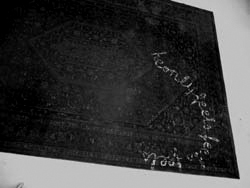
Alfombra 16 (he only feels feels feels) // 2007
Carpet. Acrylic paint on found rug. Dimensions 178 x 386 cm. Unique piece. Courtesy of the artists & Freymond-Guth Fine Arts, Zurich.
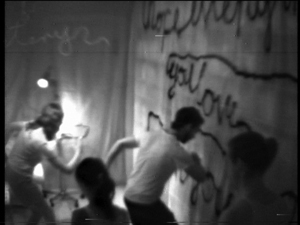
Lili Marlin // 2004-2005
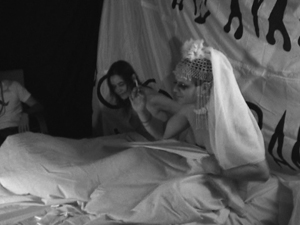
Lili Marlin // 2004-2005

Lili Marlin // 2004-2005
Lili Marlin // 2004-2005
Two performances were entwined in this film: A mechanical dance, talking people and nudity for peace, with a soundtrack by DFS singing Lili Marleen in its Arabic translation.
Nudity for Peace: Performance / dinner by CGB & WM at the studio of Johannes Raether in Paris. Camera: Javier Ruiz Gomez + ?
& Mechanical Dance: Choreography / improvisation / proposition for 4 dancers: Erik Göngrich, Jared Gradinger, Gudrun Herrbold, Laurie Young. Camera: by CGB & WM. Soundtrack: “Lili Marlin” (“Lili Marleen” sung in its arab translation) performed by DFS (Bene Abel, CGB, WM)
“Nudity for Peace” is a memory of a moment in protest culture. Performed as a non-frontal restaging of the “bed-in” by Yoko Ono and John Lennon, conflating this with the famous image of them being naked at Ringo Starr’s basement apartment. “Mechanical Dance” shows trained and untrained bodies moving like lively machinery. An uncanny reality opens up watching them dance. The same 3 banners were installed in both locations to create a continuity of space.
“Lili Marleen” is based on a poem written in 1915 by Hans Leip, supplemented by the poet in 1935. It was first put to music for the singer Lale Andersen by the composer and Hindemith-student Rodolf Zink in 1937. In opposition to the popular taste of the time Zink had chosen a lyrical interpretation over a martial one. The song had at that point no outstanding success. In 1938, Norbert Schultze, known for compositions like “Führer befiehl wir folgen dir” and “Bomben gegen Engeland” set a second time the poem to music. Using a “subtle march rhythm” this version became probably the most successful song of the 20th century, being translated into more then 40 languages by the end of WW 2. Although the war was held in places where Arabic was the mother tongue, for reasons unknown, the lyrics were never translated into Arabic.
Courtesy of the artists & Freymond-Guth Fine Arts, Zurich.
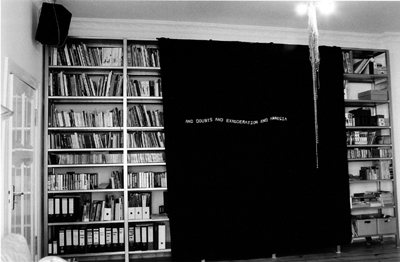
Black Banner 2 - AND DOUBTS AND EXAGGERATION AND AMNESIA // 2004
Banner. Pearls stichted on silk. Dimensions 300 x 400 cm. Unique piece. Courtesy of the artists & Freymond-Guth Fine Arts, Zurich.

Maren (White Falda) // 2007

Maren (White Falda) // 2007
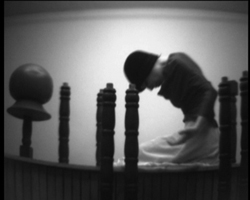
Maren (White Falda) // 2007
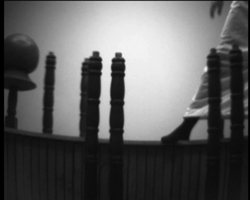
Maren (White Falda) // 2007

Maren (White Falda) // 2007
Maren (White Falda) // 2007
A film by Cristina Gómez Barrio & Wolfgang Mayer, starring Maren Maurer. Music performed by DFS (Bene Abel, CGB, WM) over Ravel “Pavane pour une Infante défunte” filmed at General Public, Berlin on “New Tribune” by Rita McBride & Manuel Graf.
Between a dream situation and an atmosphere of interiority and loneliness. White Falda is a dancer and a princess who plays around and with the space, trying exercises in beauty and self entertainment with her gestures and clothes. Over the dreamy piano composition of Maurice Ravel “Pavane for a Dead Princess” comes “Briganti”, an ancient Neapolitan song of protest and opposition to power, which challenges the harmony of the dance.
Courtesy of the artists & Freymond-Guth Fine Arts, Zurich.
Discoteca Flaming Star
Discoteca Flaming Star, 1998 gegründet von Cristina Gómez Barrio und Wolfgang Mayer, ist ein interdisziplinäres künstlerisches und kollaboratives Performance Projekt, eine Rockband, beziehungsweise eine Gruppe von Personen, die Lieder spielen, welche sie als eine persönliche Erwiderung auf politische, soziale und historische Ereignisse verstehen.
Das Werk von Discoteca Flaming Star geht dem Interesse nach, Musik und Text als Grundlage einer vielschichtigen künstlerischen Auseinandersetzung zu nehmen, deren jeweilige Ausarbeitung personell und kontextuell angepasst wird und formal unterschiedliche Schwerpunkte hat. Stets wird dabei jedoch versucht, die Spannung zwischen performativen und räumlich statischen Elementen einer Ausstellung, zwischen Performer und Publikum, Subjekt und Objekt auszuloten. Dient die Gleichzeitigkeit und Dichte der Performance darin, dabei das Begehren inszenieren, auf der Bühne zu sein und sich zu zeigen, lassen ihre darüber hinausgehenden Rauminstallationen die Ausstellungsräume als solches zur Bühne werden, und die Zuschauenden zu Performenden. Discoteca Flaming Star selbst bringt Lieder über Liebe, Konsum, Hingabe und Feminismus auf die Bühne. Bauchtanz, Schnulzen, grossartige schlechte Lieder und Dinge, die zusammen gehen, obwohl sie das nicht sollten. Discoteca Flaming Star sind haltlose Fans und trinken von Anita Berber, von Warhols Perücke, Geistern, Rita McBride’s Arena, Gregg Bordowitz, Mary Shelley, Karl Valentin & Lisl Karlstadt, der Wiener Gruppe, Alvaro, Joey Arias und Raven O – und nennen das Ergebnis “Hardcore-Karaoke”.